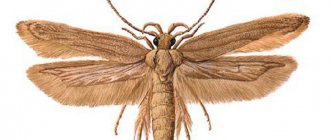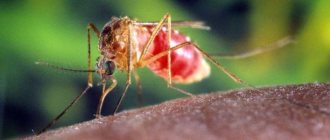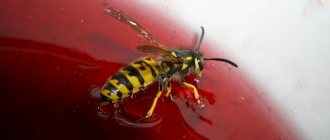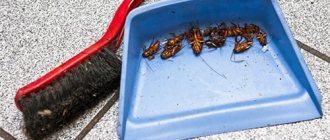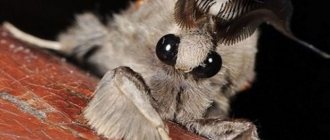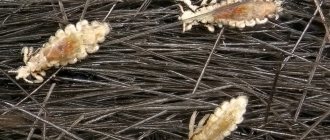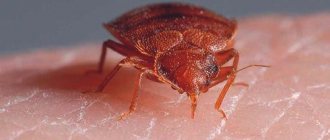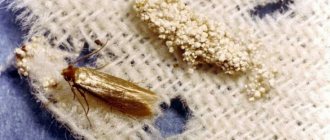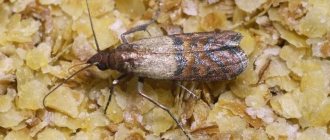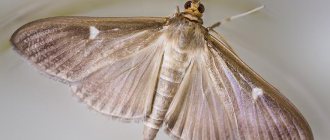How to get rid of food (grain, fruit) moths?
A moth is a parasitic insect that feeds on various cereals, food mixtures, flour products, and also clothing.
Depending on what moths feed on, they are divided into several varieties, which we will briefly consider. The food moth is an individual that has wings whose dimensions reach up to 10 mm. Butterflies have no colors, so they have a gloomy appearance, which sometimes blends them in with the food where they live.
Flour butterfly. This moth can be distinguished by the brownish color of its wings, which often blends in with flour products, making the insect invisible. But you just have to look closely to find moths in a package of flour products.
This is what a common food moth looks like, which can be found in our kitchen.
Mill moth. This butterfly is found in rare cases, as it lives mainly in utility rooms where grain crops are stored. But occasionally, a butterfly can still be found in the kitchen in a bag with cereals such as corn, barley, wheat and barley. The moth has a significant difference: the upper part of the wings has a dark gray tint, and the lower part is white.
Cocoa moth. Despite the name, the cocoa moth feeds on various types of cereals, and you can meet it much more often than the preliminary representative. This moth has a lightish tint to its wings, so it blends in well with food.
Barn moth. This type of moth has a bright shade of wings, so it is almost impossible to confuse it with other species. This type of insect is very difficult to remove.
Despite the significant differences between different types of food butterflies, their larvae are practically indistinguishable from each other. The larvae hatch into caterpillars, which often measure no more than 1.5-2 cm.
Butterfly larvae are laid directly in their habitats, so after the caterpillars are born, they begin active feeding. After a short time, an adult emerges from the caterpillar, which is ready for further reproduction.
The result is spoiled food that must be thrown away immediately.
Some thrifty housewives try to save cereals by heating them in the oven at a temperature of 60 degrees. But it’s better not to waste time and endanger your household.
Eggs and larvae are not easy to destroy. Surviving parasites (even in small quantities) can cause severe intoxication and cause considerable harm.
The use of chemicals in this case is unacceptable, since we are talking not only about destroying the pest, but also about preserving the health of all family members, so we will describe how to remove moths from an apartment using “grandmother’s methods”:
- contaminated products must be thrown away, those that survive must be stored in jars with tight-fitting lids;
- thoroughly wash all kitchen cabinets with soda solution;
- limit moths' access to water. An adult cannot eat, but can drink, this helps it reproduce successfully. It is necessary to inspect all water pipes and eliminate all problems;
- treat all the cracks in the kitchen unit with a vinegar solution, this is where the pest lays eggs;
- place laurel or walnut leaves in all corners of the kitchen, as well as in cabinets;
- place chestnut fruits in shells (pre-dried) inside each kitchen cabinet, as well as in jars with flour and cereals; it is advisable to change the chestnuts from time to time;
- place jars of black allspice (peas) in the cabinets;
- keep the sink clean, wipe it dry after each wash;
- The ventilation hole in the kitchen and bathroom must be covered with a fine mesh to prevent visits from neighboring moths.
The appearance of moths can be avoided if you keep your home in order, as well as properly store clothes and food. But if, after all, the insect managed to get into the house, do not despair, use the advice in this article on how to get rid of moths at home.
These simple methods of struggle will help you destroy uninvited guests and force them to avoid your home in the future.
Furniture moth
This type of moth is light yellow in color with golden wings. The female lays up to 300 eggs within a half-month. The larvae begin to move actively only when they gain access to adequate nutrition. The moth lays its eggs in crevices of wood, under furniture upholstery, eating it. Every homeowner dreams of getting rid of moths in their apartment. Indoor moths are afraid of sunlight, so the larvae begin to hide in cocoons. Unfavorable conditions prevent caterpillars from developing and parasitizing.
Furniture moths are similar in appearance to a food pest; it is quite difficult to distinguish them. If you look at a photo of a moth, only a specialist can recognize whether this individual eats wool or cereals.
Where do moths come from in the house?
The reason for the appearance of all kinds of parasites and pests in the house is most often the unsanitary condition of the home. Moths can appear even in a house where perfect cleanliness is always maintained. But where do moths appear in the house? Here you need to consider what type of insect you have.
There are two fundamentally different species that live in the house: clothes moths and food moths. Despite the external similarity, these two species have different biological natures, and, accordingly, they each penetrate into the house in their own way. What clothes and food moths look like, as well as what moth larvae look like, look at the photo.
Clothes
Clothes moths are just that pest that loves to feast on fur and wool, while hopelessly ruining your favorite things. Most often, the pest is brought into the house with larvae and pupae, which have settled on clothing, shoes with natural fur, and furniture upholstered from natural materials. These can be either used items or completely new ones. Clothes moths settle in closets, multiply there and begin to spoil woolen clothes, furniture upholstery, carpets and fur products. It can be carried by long-haired dogs, whose fur can be used by the pest as a temporary shelter.
Food
We figured out what clothes moths eat. Now let's find out what another type of moth eats: food moth. This pest settles primarily in the kitchen and in areas where food is stored. Most often it is brought from the store with groceries, even if they are in original packaging. Favorite treats: cereals, nuts, dried fruits, seeds, flour, milk formula, dried berries and dry pet food. The reason that larvae appear in the product may be unsealed packaging, as well as violation of storage standards in a store, warehouse or granary. In some cases, residents of the lower floors of apartment buildings, the first floors of which are occupied by grocery stores where food storage standards are not observed, may also suffer from the invasion of harmful butterflies. It is almost impossible to detect pests in open areas of the kitchen; insects prefer closed cabinets in which they live and feed.
Appearance and characteristic features of moth larvae
Live and in photos, moth larvae are small white or slightly yellow caterpillars. Whatever species the moth belongs to, its larvae have powerful gnawing jaws and a clearly visible brown head. The photo below shows a clothes moth larva:
In most moth species, the larvae look like small worms, but this comparison is not entirely correct - real worms do not have limbs, and the moth caterpillar, like any other insect, has six pairs of tiny legs.
The food moth larva looks almost the same as the clothes moth larva. However, the caterpillar of a clothes pest will never feed on flour or cereals, and vice versa: food moths, for example, are several species of moths whose caterpillars are not able to feed on textiles. The photo below shows what the larvae of granary food moths, a well-known food pest, look like:
It is characteristic of clothes, furniture, carpet and fur coat moths that their larvae make a cover for themselves - a small cocoon from their own silk-like substance and the remains of damaged tissues, which the caterpillar puts on itself and with which it moves short distances. And in the furniture moth, the larva even makes a whole house for itself in the form of a tunnel made of silk, food debris and excrement:
Similar cocoons are created by the larvae of food moths. The photo shows flour spoiled by fire. Lumps are visible, which are cocoons covered with flour:
Impact of temperature
Moths do not tolerate too high or low temperatures. An adult flying specimen dies at 2 °C below zero. A decrease to -10 °C has a detrimental effect on larvae, eggs and pupae. The moth also dies at a temperature of 40 °C. Washing items in water heated to 50 °C will help destroy the oviposition and the larvae themselves.
To protect outerwear, as well as woolen clothing and fur items from being eaten by moths, they are taken out into the fresh air (balcony or terrace) for several days in winter. Some people practice freezing their own homes to get rid of harmful insects. But this method is only suitable for private houses where there is no central heating.
In summer, on clear days, it is effective to warm up clothes under the sun's rays. The moth does not tolerate bright light, so the butterflies fly away immediately, and the larvae gradually die when heated. It must be taken into account that periodic shaking of things will allow you to get rid of caterpillars that are loosely attached to any surfaces.
It is easier to initially prevent the appearance of the pest by using methods aimed at repelling the insect.
Dryness and light in the room are also undesirable for moths
Moths are afraid of low humidity and bright light. Therefore, it is useful to take clothes for prevention out onto the balcony and into direct sunlight. The larvae die rather quickly from this. The temperature effect also works here due to the gradual heating of clothing.
On a note
Clothes moth larvae generally stick weakly to clothing, and shaking things well helps remove most of the caterpillars.
It is also useful to read: How and with what to remove moths from an apartment
What do moth larvae eat?
The consequences of the life activity of the house moth larvae look like a mixture of gnawed fabric, fur or dry foods mixed with a dusty substance.
Wool, fur, clothing and furniture insects feed on natural or mixed fibers, including some types of synthetics. The fur moth is capable of laying a path along its route, which will look like a shorn strip.
Moth eats fur coat
A smaller variety of furniture parasites immediately selects upholstery areas with a large amount of material for laying eggs, so that the hatched individual is provided with food from the moment of birth and cannot die. A hole appears in the place where furniture moths live.
Feeding individuals destroy the structure of grains and cereals, turning them into dusty mush, held together by the biological material of caterpillars and eggs.
Moth eats cereal
Prevention
To prevent the moth larva from actively destroying valuables or food, it is important to know how to prevent the pest from appearing in the house. To protect your home, it is important to follow a number of rules.
So, only washed items should be stored in closets. From time to time, all woolen or fur products and natural fabrics must be ventilated in frost or sun.
Other rules of prevention:
- Fur and wool must be periodically treated with insecticides.
- Items cannot be placed in plastic bags.
- Herbs that repel parasites (tansy, wormwood, lavender) should be placed in the wardrobe and chest of drawers.
- You can place citrus peels in the kitchen.
- On shelves with clothes you need to place pieces of foam rubber soaked in essential extracts.
- All food products that can be damaged by larvae must be periodically sorted and stored in closed containers.
- Regularly you need to carefully inspect all seams and folds on things for the presence of parasites.
Microscopic larvae can ruin expensive and valuable things. Therefore, it is easier to prevent their occurrence than to purchase a new fur coat, furniture or carpet.
To do this, it is important to follow the prevention rules described above. And at the first sign of moths appearing in the house, carry out a thorough disinfection.
Preventive measures
To prevent the weakening or death of bee colonies, it is recommended to carry out a number of preventive measures. This will help you avoid getting acquainted with pests that are difficult to get rid of:
- planting repellent plants (garlic, geranium, mint, wormwood, thyme) next to the apiary;
- storing honeycomb frames in a clean, ventilated area;
- timely repairs, cleaning of hives, constant checks;
- providing bees with free access to all areas of the hive.
Bee moth is a large or small wax moth that is dangerous for beekeeping. Harm is caused by larvae and caterpillars gnawing honeycomb cells, eating honey, bee bread, wax or propolis. If you do not get rid of these pests, the bee colony will weaken, die or fly away.
Temperature, humidity, light
The use of a temperature regime is rather an element of the fight to kill moths, rather than a prophylactic, warning agent. It is recommended that once every three to four months, regardless of the seasonal temperature, you bring things potentially interesting to moths out into the light, while simultaneously cleaning and treating the cabinets.
Are moths afraid of frost? Yes very! Already at air temperatures just below 0°C, adult individuals begin to die, eggs and larvae barely survive to -10°C. The same, fairly moderate limit, beyond which the death of moths occurs, is also in the plus range: 40–50°C is sufficient to destroy butterflies and pupae.
“If it happens in winter, then no drugs are needed! Take your things out to the balcony, give them a good shake and leave them for a couple of hours. Moths are terribly afraid of the cold! You can do the same thing in the summer, by taking your clothes out into the sunlight!” Kira Mikhailovna, Donetsk
Varieties of moths
There are more than 200 thousand species of moths. The most common types:
- Furniture moth is yellow-pink in color. It starts in hard-to-reach areas of furniture and multiplies very quickly. In a few days, the female is able to lay 280-300 eggs. Eats furniture upholstery that contains natural fibers, carpets, fur products;
- Wool moths are a pest that is most often found in residential buildings. The moth butterfly is light brown in color without hairs on its head. Most often found in woolen products, museum exhibits, flour and grain products;
- Cabbage moth - mainly affects cruciferous crops. It has a light brown color, with fringe on the lower wings. This species is distributed throughout the world. Harmful to radishes, cabbage, mustard;
- Fungus moth - this type of moth does not live at home. The butterfly is brown in color with white spots. It is found in forests and parks, where it feeds on mushrooms and rotten tree bark;
- Poplar moth - found on poplars when young foliage appears and before the downy period. The moth has a variegated coloration with black dots and fringe on the wings. It often ends up in living spaces along with down, but it is completely safe for humans. Poplar moths often attack fruit trees and garden flowers;
- Wax moth - found in hives and harms bee larvae, and also eats honey and pollen. It is also called bee. A medicinal tincture is made based on wax moth larvae.
Cabbage moth
This parasite causes damage to cruciferous crops. Externally it differs from other types of moths: the body is oblong in shape and light green in color, covered with small hairs. You can easily confuse an insect with a straw if it folds its wings. The wings themselves are framed with fringe at the edges. The larvae have characteristic brown heads.
In terms of activity, cabbage pests are no different from the rest: they are inactive, fly poorly, and rarely move very far from the place where the cocoon is left. Parasites lead a solitary lifestyle and rarely gather in groups. On a leaf you can see one, maximum two individuals.
It is easy to detect and identify the eggs of the parasite: they are elongated and very small. The egg is up to 0.5 millimeters long and only 0.2 millimeters wide. The green color perfectly camouflages them on the foliage.
The smell is different from the smell
Since moths are sensitive butterflies, they cannot tolerate certain odors. This is what will help us in the fight against it.
The most unpleasant aromas for this insect are:
- geraniums;
- wormwood;
- tansy;
- lavender;
- fresh citrus peels;
- mint;
- eucalyptus essential oil.
Bunches of these plants can be folded into specially sewn bags or simply wrapped in a cloth, and then placed in the closet and kitchen cabinets.
After all the things have been reviewed and a general cleaning of the wardrobe has been carried out, you can drop a couple of drops of essential oils onto the shelves, which will repel the pest.
A pot of geranium on the windowsill copes well with this task, since the pest also cannot stand its smell.
The right approach to solving the problem and following the rules for storing food and things will not allow the pest butterfly to settle in your home.
Laundry soap
In fact, laundry soap is a kind of analogue of tablets and sections against moths. It works on the same principle - its smell simply repels the pest. To combat moths, pieces of soap are placed in clothing pockets or simply in closets. For these purposes, ordinary laundry, dust and strawberry soap can be used.
Among all the effective and truly working moth repellents, there are also those that moths are not afraid of at all. For example, there are people who quite seriously rely on spells against moths - they are used by lovers of esotericism and antiquity. You can try to fight moths using such methods, but when you finally want to get rid of moths, you will have to use something more effective.
Useful video: several effective ways to combat moths in an apartment
Folk remedies
According to the results of numerous scientific studies, folk remedies for moth control turn out to be almost completely safe, but not always as effective as chemistry. If there are too many insects in the house, then these methods may not help, since they are aimed primarily at repelling them. Then it is better to first treat the apartment with strong chemicals, then do a general cleaning and use traditional methods to protect yourself from its reappearance.
Folk remedies for moths are based on centuries-old observations of this insect. Our ancestors, who did not have strong chemical products at their disposal, observed what smells moths did not like and in what conditions they did not survive.
An interesting fact was that at a temperature of 15-20 degrees below zero, not only moth larvae die, but also its eggs. So the easiest way is to just take things out into the cold for more than a few hours. Which was easy to do in the northern regions of Russia with harsh climatic conditions. Those living in warmer regions have adapted to repel moths using the smells of various plants.
The most effective folk remedies for moths turned out to be:
- Lavender flowers. Usually they use dry ones, which they literally sprinkle all the things in the closet. Moreover, according to popular belief, lavender removes negative energy, and bedding and underwear saturated with its scent calms and improves sleep.
- Garlic or onion. It helps against moths perfectly, but it has a strong, specific smell that will not be very pleasant on clothes and other things. This folk method of protection is good in kitchens and food pantries.
- Vinegar. It will also help protect kitchen cabinets in which cereals are stored from moths - a real treat for moth larvae. If you wipe their shelves at least once a week with a cloth soaked in vinegar diluted with half and half water, there will be no smells and no harmful insects will appear.
- Orange peels. Food moths are also afraid like fire of the smell of orange essential oil, which its dry peels retain for a very long time. If you spread their pieces all over the kitchen and cabinets, the butterfly will not have a single chance to lay eggs and hatch larvae.
- Essential oils. The simplest and most pleasant way to fight moths, especially since the choice here is quite large. The oils that help best are: tea tree, thyme, rosemary, patchouli, cloves, lemongrass. Having chosen a scent to suit your own taste (or you can have your own for each room), you need to soak a piece of felt or cotton wool in oil and place it in the insect’s favorite habitats.
- Mint leaves. A great way to protect wardrobes. The subtle mint aroma, even mixing with the smell of perfume, will further highlight and reveal it. Mint leaves should be replaced every six months.
- Pyrethrum moth powder. It is prepared from chamomile and is effective in places where insects accumulate.
- Geranium. As it turned out, geranium flowers in the house are not only beautiful, but also very useful. The moth can't even stand the smell of it. And if you place only one pot with this useful plant in each room, the moth will go to look for another habitat.
The methods listed above are only the simplest and most effective folk remedies for moths. In fact, there are many more of them, and after trying several products it’s easy to find yours. The main thing is to start a moth control campaign as early as possible, as soon as the first moth is found in the house.
How to use freezing
Things are taken outside or to the balcony, where they are hung in such a way that the fabric stretches out as much as possible. When hung in this way, all the moths that live in the clothes die. If an insect has settled in a fur coat or carpet, you first need to roll things around a little in the snow, and then lightly beat them with a beater (the carpet can be done harder).
While moths in all their forms are dying in the cold, like a coachman in the steppe, you need not to waste precious time and treat cabinets and other spaces. This will allow you to get as close as possible to the complete destruction of the pest. Surfaces are wiped free of dust and wet cleaned.
Insecticide treatments may use a method such as cold fog killing. The fog itself is nothing more than a very finely sprayed chemical that settles on surfaces and kills insects. It can be called cold conditionally, since the sprayed liquid is at room temperature. This method of fighting domestic insects is widely used by companies that come to a call, assess the scale of the disaster and treat the premises using a special evaporator (vaporizer).
Before returning things to their place, it is better to place natural repellents - herbs and spices - there. Dried plants such as:
- peppermint;
- lavender;
- sagebrush;
- tobacco, etc.
For spices, it is better to take black peppercorns, dried ginger, and a cinnamon stick. The required substance is sewn into a gauze or light fabric bag and hung between hangers and laid out on shelves. I don't like moths and the smell of toilet soap.
The effectiveness of freezing can be increased by using this method repeatedly several times at intervals of 3-5 days.
If it's summer outside, small items can be kept in the freezer for a day (hat, scarf, mittens, etc.). Large clothing items cannot be treated in this way, but summer heat and solar ultraviolet radiation are also unpleasant for moths. In the summer sun, wearing well-warmed clothes, a fairly high temperature develops, which has a detrimental effect on laid eggs. And bright sunlight is harmful to adult moths.
What does it eat and what is it afraid of?
The kitchen moth is practically omnivorous. She eats not only groceries, but also fresh fruits, and even dried herbs or spices. Adult flying individuals do not feed at all: they lack mouthparts and a digestive system. The threat is posed by food moth larvae, which require a lot of food to pupate.
The following products are at risk:
- Cereals – semolina, rice, millet, buckwheat.
- Pasta.
- Cereals – oat flakes, seeds, bran.
- Dried fruits – prunes, dried apricots, raisins, figs.
- Flour and bakery products: baked goods, cookies, crackers.
- Cocoa and mild spices.
- Nuts – hazelnuts, almonds, cashews.
- Sugar.
Food moths cannot tolerate the smell of citrus fruits, lavender, tansy, wormwood, rosemary, dill, and cloves. Therefore, for preventative purposes, you can hang dried bouquets of herbs in the kitchen or use essential oils - to scent the air, wipe cabinets, add to water when wet cleaning.
Stages of transformation into food moth from eggs.
So, what is the moth afraid of?
A lot of things actually. These include various odors, and certain, and far from the most critical in our understanding, temperature indicators; finally, it can be exterminated using folk remedies or modern chemical insecticides.
But let's start in order. There is a reasonable opinion that it is simpler and cheaper to organize preventive measures and create a kind of barrier system for moths than subsequent costly control of extermination.
Smells
The basis of any method of repelling moths is an indisputable fact - moths are afraid of smell!
The source of the aroma that repels these insects can be anything:
- Plants and herbs.
- Some types of fruits.
- Essential oils.
- Synthesized drugs.
The smell of which plant is moth afraid of?
The most effective herbal remedy that stops the appearance of moths is lavender. The aroma of the flowers of this plant, pleasant to the human sense of smell, but not tolerated by moths, will be an excellent preventive remedy in a chest of drawers or wardrobe.
They also do a good job of repelling moths:
- Tansy inflorescences, however, as with many other types of insects.
- Wormwood is a specific, rather strong, but not for everyone's scent.
- Rosemary is good for everyone, but it loses its flavor extremely quickly.
- Dill, well, it’s clear here - kitchen, not for long, cheap.
When choosing a specific plant for organizing preventive measures in your home wardrobe, you should focus not only on personal preferences in fragrances
It is important to remember that the period in which the smell of each plant “works” is limited
Dried herbs retain their properties for several months. Lavender is the recognized leader here too. In addition, an extremely rare, in comparison with other herbal remedies, addiction to its smell of populations of a particular area was noted.
Fruits
Here we are talking, as a rule, about citrus fruits. Lemon, tangerine, orange are fruits that have a very pungent odor that perfectly resists moths. Most often, for prevention, the zest or peel of these fruits is used.
Essential oils
Another very interesting and pleasant to the smell answer to the question of what smells moths are afraid of is essential oils.
In principle, the base on which this or that extract is created are the same plants and fruits:
- Lavender.
- Eucalyptus.
- Patchouli.
- Lemon.
- Coniferous leaves.
The highlight of this method is that the extract from many other flora specimens, through some chemical additives and improvements, receives a serious bonus - odor persistence and high concentration of the substance. This increases the duration of action of this product and expands the scope of its application.
Synthetic scents
A wonderful modern method used by many is sections
or sachet,
special devices that emit a strong, moth-repellent odor. The working preparations in them are chemically composed analogues of natural substances, and, quite often, with a certain proportion of insecticides. So to speak, a two-in-one method - it frightens and kills!
What are they afraid of?
Here it must immediately be said that an adult moth butterfly and its caterpillar are two different creatures, and their perception of certain factors as a threat to life is very different.
Aromaprophylaxis
It is much easier to fight a butterfly, and even easier to prevent its appearance in the house. To achieve this, many proven folk methods have been used very successfully for many decades, most of which are based on repelling insects with unpleasant odors.
We list all the main sources of such aromas that repel these pests.
These include the following:
- citrus fruit peel;
- laundry soap;
- vinegar;
- geranium flowerpots;
- tansy and wormwood inflorescences;
- dried lavender or its oils;
- fragrant tobacco;
- garlic cloves
Among these remedies, we note the excellent preventive effect of laundry soap, as well as the smell of garlic. These products are available to everyone, and perfectly perform their repellent function against adult insects.
And lavender, by the way, is even used as a flavoring agent in the creation of special chemical moth repellents.
Sunlight and high temperature
If aromatic protection, by and large, helps well in repelling adult insect pests, then intolerance to light and sunlight has an equally detrimental effect on both butterflies and moth larvae.
As a preventive measure, and simply when fighting pest larvae already found in an apartment, an excellent way to get rid of them is by airing and frying items of clothing, for example, in the sun in hot weather. Even after hanging a fur coat at less than 30 degrees, most caterpillars die in the sun's rays or are easily blown away by the wind.
Also a good way to destroy insect larvae and eggs is to wash items at the maximum permissible water temperature. If we are talking about furniture or carpet, you can use a technical hair dryer to blow hot air.
In general, temperature can be considered our ally in the fight against these pests. At a temperature of 45-50 degrees, the moth will certainly die, including adults, larvae and eggs.
Frost and cold are our friends
Are moths afraid of frost? Don't even doubt it. This insect fears sub-zero temperatures even more than light and heat. Already when the ambient temperature drops to 10, the insect feels very uncomfortable. The rate of development of larvae and maturation of pupae slows down significantly, while adult butterflies begin to look for more favorable conditions for laying eggs.
When the thermometer stops at zero, insects and their larvae usually die, or, in the best case for them, are on the verge. If the room temperature is minus, this is already a death sentence for insects of all types and their caterpillars.
Chemical weapons against pests
The most reliable method of influencing this pest would be, of course, the use of chemical agents to kill moths and other indoor insects.
These include all kinds of sprays and aerosols, as well as evaporative insecticides.
Let's start with the last ones. Fumigators have proven themselves to be excellent repellers and destroyers of flying insects such as mosquitoes, flies and moths.
The principle of operation of such products is to evaporate special plates or liquids using heat.
Thus, the insecticide they contain either kills insects indoors or forces them to look for a fifth corner.
Among such evaporators, the well-known fumigators and Raptor plates perform well.
This manufacturer is an absolute leader in the field of creating means of protection and control of insects in the vastness of the CIS countries.
If we talk about spray sprays, there are also a number of recognized options that have good reviews from users, including the following:
- Antimol;
- Armol;
- Raptor “Protection from moths”;
- Dichlorvos NEO or BUNTOKS;
- Moskital “Protection against moths”;
- "Clean house".
In a word, there is a choice. All of these products serve their purpose equally well; the difference may be in price and degree of harm to humans and pets. This is definitely the most compelling answer to the appearance of moths in the house, be it butterflies or even their larvae.
However, not everyone wants to use insecticide spraying in the kitchen, even if in the specifications of some aerosols manufacturers assure that the product is completely safe for humans. Still, you need to understand that getting a toxic substance into food or on the dinner table is not good.
Therefore, let us once again recall the preference of fighting food moths in the kitchen using preventive methods and evaporative fumigators. In any case, make your own decision here and at your own risk.
OUR READERS RECOMMEND!
To get rid of insects, our readers recommend the Pest-Reject repeller
. The operation of the device is based on the technology of electromagnetic pulses and ultrasonic waves! Absolutely safe, environmentally friendly product for humans and pets. Read more here...
How to prevent moths from entering and destroying your home?
To prevent moths from breeding in the kitchen, try to take the following measures from time to time:
- Periodically inspect kitchen cabinets, drawers or compartments where food is stored;
- Throw away spoiled or contaminated food and wash storage containers;
- Wipe kitchen cabinets, drawers and other places where you store food with a vinegar solution. To do this, dilute 30-40 ml of 5% vinegar per 5 liters. water;
- Also, during wet cleaning, you can add a few drops of essential oil (lavender, orange, rosemary) to the water;
- Install a very fine mosquito net on the ventilation to prevent entry through this route;
- Place fragrant herbs in fabric bags in storage areas;
- Ventilate the kitchen regularly.
REFERENCE: Food moths do not like the smell of geranium. This flower on the kitchen windowsill will reduce the chances of the pest spreading.
To prevent clothes moths from multiplying, you should adhere to the following tips:
- In the summer, take items made from natural fur or wool out into the sun;
- Shake clothes that are vulnerable to moths; the larvae do not adhere well to the fabric;
- Periodically wipe the shelves in your closet with water and essential oil;
- Use special anti-moth aerosols to treat furniture, wool and fur items;
- Install special traps or repellents in the closet. The same applies to furniture with natural upholstery;
- To repel moths, use a fumigator;
- If you are concerned about outerwear made of natural fur, leave fabric bags with tobacco in your pockets for a warm period of time.
Synthetic scents
Synthetic odors are used to protect fur and wool products. And the most popular option, in the preparation of which synthesized odors are used, is considered to be a section or a special sachet.
A section is a kind of device that is imbued with a certain aroma. It is complemented by fastening elements, through which the section is attached to the back of the cabinet or chest of drawers. Gel sachets are used to repel pests. They are often used for preventive purposes.
The operating period of the sections is short. Experts recommend replacing every 1-1.5 months. The corresponding recommendations are present in the instructions supplied by the manufacturers. There are also sachets on sale that can be used for 6–12 months. They are suitable for protecting individual premises.
Synthesized odors are also used in the preparation of unique tablets. They are dispersed in places where fur items, food, or other objects attractive to pests are located.
How does this pale butterfly develop?
In their development, insects undergo a complete transformation.
That is, the stages of moth development change four times: egg, caterpillar, pupa, adult (imago). Eggs do not pose a danger to things or products, but their presence is also unpleasant. The shape of the eggs of a harmful insect is oblong, cylindrical. Eggs develop differently depending on the external temperature. For example, at an air temperature of +30-32, they need a week to ripen. And at a temperature of +15, eggs develop three times slower.
But the caterpillars do the most significant damage. Their oral apparatus is designed both for biting and chewing food, and for weaving silk thread. In their natural environment, caterpillars feed on pollen, animal hair and fur, dead insects, and particles of organic tissue in burrows where animals live.
If fruit or grain parasites appear in the apartment, then cereals, beans, nuts, tea or dried fruits contaminated with their metabolic products should be thrown away immediately. Feces of caterpillars, their dead skins and particles of epidermis can cause allergic reactions and intoxication in people.
Over the entire period of its development, which can be from a month to two and a half years, the moth caterpillar molts from 5 to more than 40 times. Therefore, what moth larvae look like depends on the degree of their maturation. When the caterpillar reaches the peak of its development, it stops feeding and begins to spin its cocoon.
Pupation is a very important stage in the development of any butterfly. In comfortable environmental conditions, in hot weather, the process of development of the pupa before the moth is born as a young butterfly will take no more than 8 days, but if the weather is cold, it can last for a month.
What do moth larvae look like in an apartment?
Caterpillars look like white, translucent worms about 1 mm long. They have six small legs that are almost invisible. The mouthparts are very well developed and are designed for biting food.
What moth eggs look like
The egg is pearly white in color, cylindrical in shape with one more sharply rounded end. The egg length is on average 0.3-0.5 mm.
Where to look for moth larvae - how to detect them?
Larvae in an apartment can be detected by the place where the butterfly appears. As a rule, they fly out from somewhere suddenly. At first glance, the insects look the same, but they can be distinguished by color: clothes - beige, light yellow, furniture - brown, kitchen - faded, grayish-white.
House butterfly caterpillars adore natural fabrics - knitwear, especially wool and fur, silk. They can damage not only clothes, but also furniture upholstery and shoes if they are made of wool or felt.
They are easy to spot. Having pulled out the thing, they will simply fall off it and the product will look the same with the characteristic gnawed holes. As a rule, these are things that have not been moved or worn for a long time.
The food caterpillar feeds on groceries. She is a lover of sweets, nuts and dried fruits, flour, cereals, cookies, bread, mild spices and much more. She can handle any dry food product. A characteristic sign of infection is its cocoon, which it flies around itself. It looks like small lumps and “pellets”. Sometimes it is difficult to determine by eye whether food has been spoiled by a pest, and this is already revealed in the finished dish.
The food butterfly has short wings and does not specifically fly between apartments and houses in search of food and habitat. It enters the home with products from a store or market - this means that all of them were contaminated at production or during storage in warehouses or barns.
The infestation of an apartment with food moths is also indicated by its larvae on the ceiling, which cause quiet horror when detected.

